Hildigunnur Birgisdóttir’s exhibition for the Icelandic Pavilion at the 60th Venice Biennale at first glance looks like a virtually empty room apart from a logo-strewn table and chair for invigilators and a few objects sparsely hung on the walls. Moreover, the sculptures tread a fine line between artwork and product, giving the space an inherently commercial feel. In fact, her show That’s a Very Large Number: A Commerzbau is an entire immersive environment (including table and chair), many of the works placed just beyond our peripheral vision on the wall or being objects that are so familiar in our quotidian lives that they almost don’t register as art. These objects are integral to the Reykjavík-based artist’s beguiling, understated exhibition, which reflects on ideas of value and beauty and how information is disseminated (even inculcated) in our consumerist society.
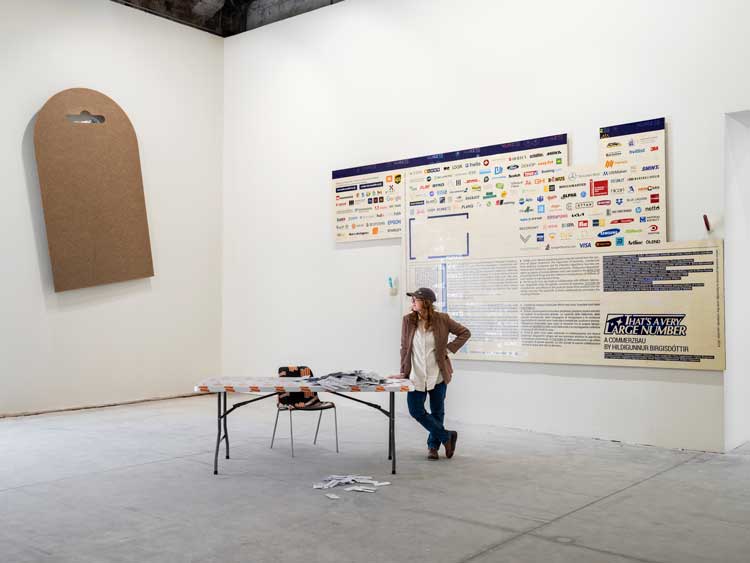
Hildigunnur Birgisdóttir: That’s a Very Large Number: A Commerzbau, Iceland Pavilion, Arsenale, Venice, April 2024. Photo: Ugo Carmeni.
At the core of her practice is an interest in the systems whereby things are produced, fabricated, circulated and accommodated in our lives. An example is the heap of wet wipes on the table bearing the slogan “healthy gums, healthy life”. “I’ve been collecting slogans of companies, but I always came back to that one,” says Birgisdóttir. “It's such a motherly, helpful message, but still not very useful in life.” In a similar vein, a fridge panel and a printer interface, respectively titled Fake News [always?] and Fake News [never!], perch on the walls: these works blink in and out of synch and one buzzes periodically in the bossy, concerned lexicon of machines telling us we need to attend to something. As per the titles, Birgisdóttir is fascinated by the slippery collation of opposing ideas in our era of fake news, where “always” and “never” can mean practically the same.
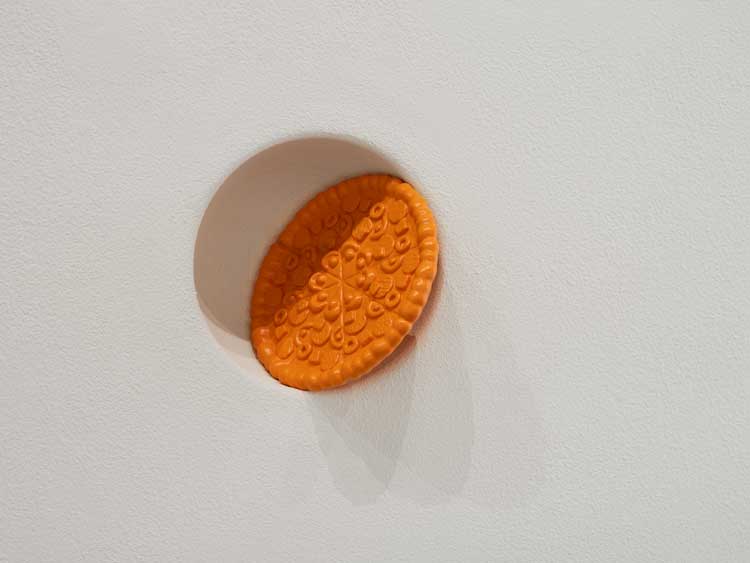
6:1 (orange). Polyamide plastic, paint. Installation view, Hildigunnur Birgisdóttir: That’s a Very Large Number: A Commerzbau, Iceland Pavilion, Arsenale, Venice, April 2024. Photo: Ugo Carmeni.
Information overload is something of a theme; a large wooden wall panel repurposed from a pavilion floor of an architecture biennale is crammed with it – from the exhibition text and floorplan to the logos of every company involved in each stage of creating this exhibition. The piece is fittingly called Infoxication, in a pleasing portmanteau of info and intoxication. Birgisdóttir does not tell us which, if any, element of the panel is most important – as is often the case in the labelling on commercial packaging. Instead, we are prompted to think about how we digest information and to recognise how reliant the art world is on the corporate world to distribute and exhibit art. As with every artwork in this show, this wall panel forces a double take, subverting our expectations of what art is and how to receive it. “There’s a silent agreement when you read the wall text to have the information that you need, and then you turn around and The Art begins,” explains Birgisdóttir. “I really wanted this space to just be art, anything you see in here is, can be considered art.”
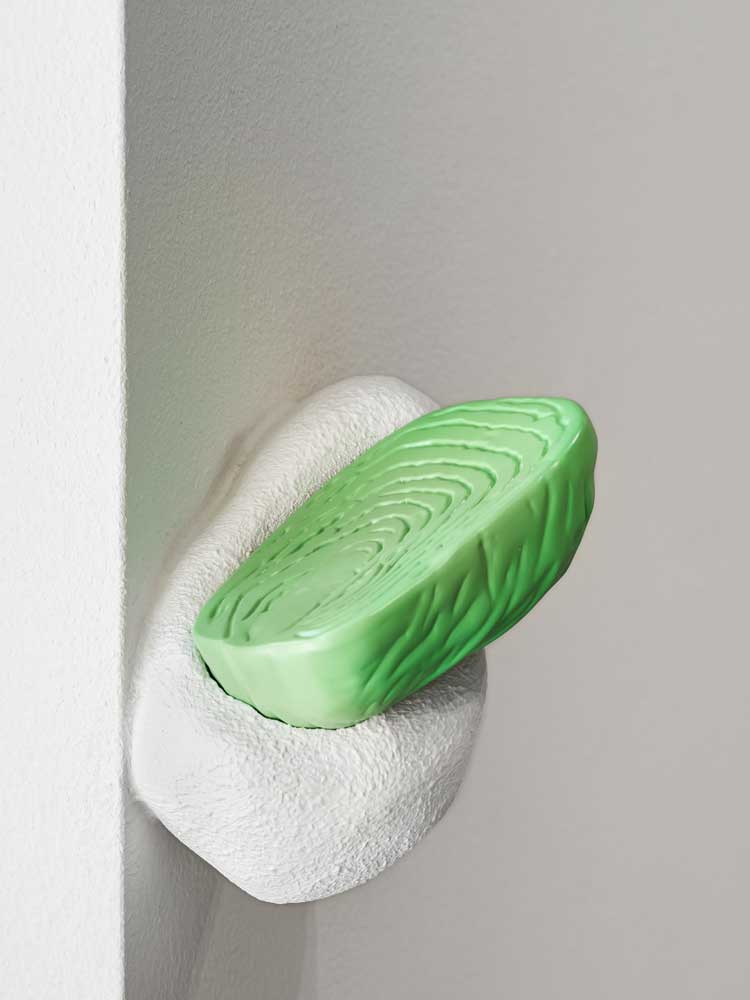
6:1 (green). Polyamide plastic, paint. Installation view, Hildigunnur Birgisdóttir: That’s a Very Large Number: A Commerzbau, Iceland Pavilion, Arsenale, Venice, April 2024. Photo: Ugo Carmeni.
Sculptures of a steak and a perfume bottle – enlarged plastic items from a dolls house – sit incongruously at either end of the wall piece; elsewhere in the room, you find a lettuce, a dentistry tool and a pizza from the same collection. Birgisdóttir is not making a superior comment here about how beholden the rest of us are to consumer culture. She accepts that she is part of the system, too, and even finds beauty in these banal objects, which are intended to convey to children the designer’s notion of the quintessential pizza with the greatest economy of visual language and replicated endlessly. “There's some beauty in the laziness of that but also just a beauty to have plastic pizza in Venice that was actually made in China as it tells you on the back,” she says.
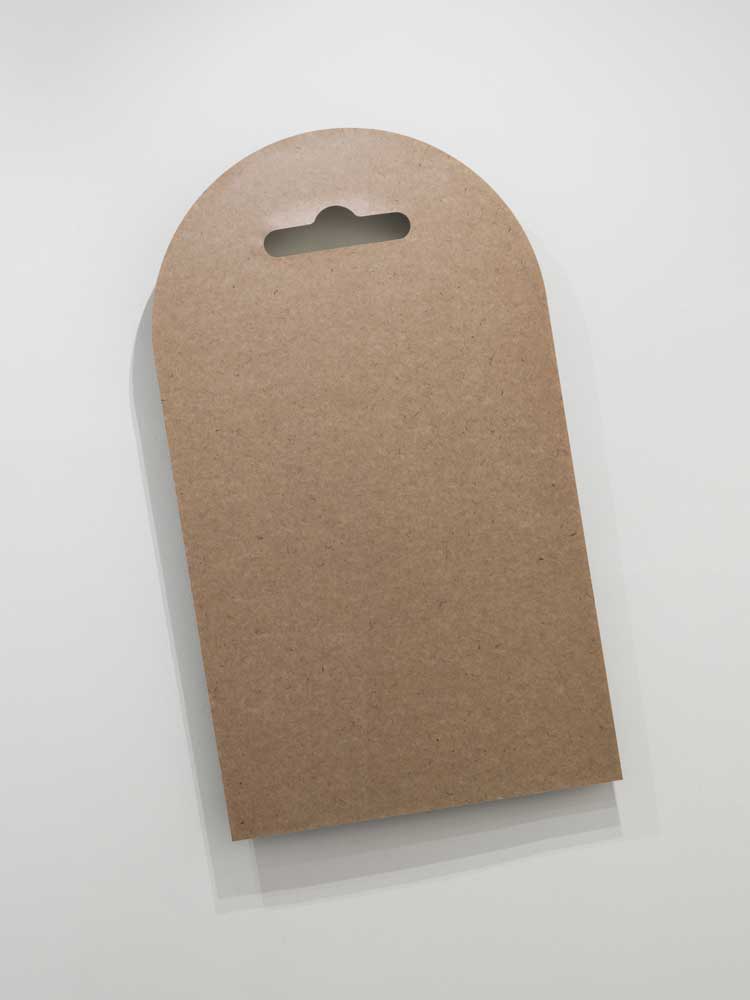
19:1 (Window Piece). Jute coffee bag veneer, Dibond, aluminium. Installation view, Hildigunnur Birgisdóttir: That’s a Very Large Number: A Commerzbau, Iceland Pavilion, Arsenale, Venice, April 2024. Photo: Ugo Carmeni.
Birgisdóttir applies the scaling-up technique to less readily recognisable items in the show too. There is a giant window-shaped form, an enlarged version of the ubiquitous backing of a makeup package and another huge form that is taken from the long central piece of card torn out when one opens a Kleenex box. “These products or objects are only made to facilitate sale or give you an easy access to the product that you actually bought,” says Birgisdóttir. She calls them “silhouettes”, items that lead an overlooked existence in the shadows, playing a necessary support role, only to be discarded without being noticed. A further layer to these sculptures is their material sourcing. One is made from recycled jute coffee bags, the other from recycled jeans by a company specialising in sustainable new products, which sounds laudable but invites questions about whether the world needs these new products at all.
Birgisdóttir has also exposed a previously covered large, sun-filled window in the space, knocked through a rough hole for a window elsewhere and painted the walls the faded yellowish white of a hardware store rather than a world-class exhibition booth. These easily missed details are a “a small nod to the fact that I am doing an exhibition so there has to be some sort of sense of self-awareness”, she says. On the outside wall across a canal, she has placed an LED work called Approx. 7%. Constantly changing, it features a live feed of 7% of a digital billboard in Reykjavík, offering abstracted snippets of the whole.
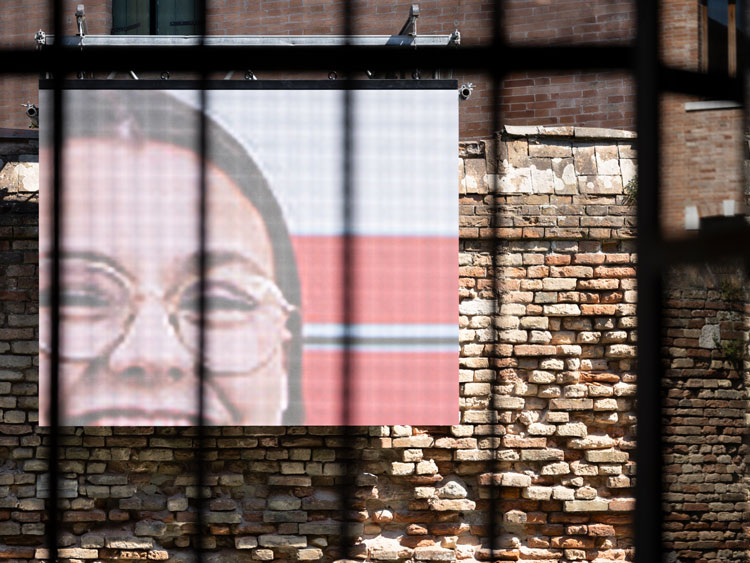
Approx. 7%. LED screen, live feed from a digital billboard in Reykjavík. Installation view, Hildigunnur Birgisdóttir: That’s a Very Large Number: A Commerzbau, Iceland Pavilion, Arsenale, Venice, April 2024. Photo: Ugo Carmeni.
Among all the attention-grabbing exhibitions around Venice, this smart pavilion, which is curated by American curator Dan Byers, feels like something of an oasis or, as the artist says, a “comma”. Rather than relying on spectacular visuals, Birgisdóttir’s work makes us pause to ponder the things we take for granted around us, the mixed messages we absorb subliminally, our own processes of evaluation. And she does it with a wry humour. Almost by sleight of hand she obliges us to consider that beauty could co-exist in something we might instinctively judge as kitsch or overtly commercial – like a part of a billboard or a plastic pizza or an information panel. As Birgisdóttir says: “I am inspired by the underwhelming.”
Hildigunnur Birgisdóttir (b. 1980, Reykjavík) lives and works in Reykjavík. In 2021, she was included in shows at Iceland’s Reykjavik Art Museum; the GES-2 House of Culture, Moscow, Russia; the V-A-C Foundation, Moscow, Russia and H2H, Athens, Greece. Her work is included in the permanent collections of the National Gallery of Iceland, the Reykjavík Art Museum, and The Living Art Museum in Reykjavík among others. Birgisdóttir graduated from the Iceland Academy of the Arts in 2003.
Hildigunnur Birgisdóttir: That’s a Very Large Number: A Commerzbau
Iceland Pavilion, Arsenale, Venice
20 April – 24 November 2024
Interview by ELIZABETH FULLERTON
Filmed and edited by MARTIN KENNEDY